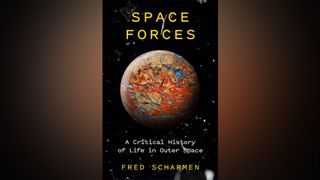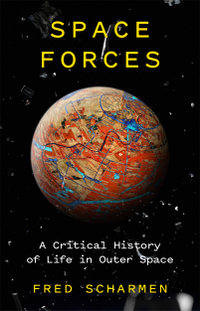Book excerpt: 'Space Forces' (Verso, 2021) examines spaceflight visions

Ideas about space exploration look different depending on who comes up with them, in what surroundings and for what purposes, architecture and urban design professor Fred Scharmen argues in his new book, "Space Forces: A Critical History of Life in Outer Space" (Verso, 2021). (Read an interview with Scharmen.)
In the book, Scharmen walks through seven different visions of space exploration. There's the 19th-century Russian thinker who argued that to erase death, humans would need to stretch their control deep into space. There's famed German-turned-American rocket engineer Wernher von Braun, who believed spaceflight was worth any cost, and American physicist Gerard O'Neill, who dreamed of spinning cities in orbit. And of course, there's today's world of billionaire-led commercial spaceflight.
Related: Best space and sci-fi books for 2021
Space Forces: A Critical History of Life in Outer Space | <a href="https://target.georiot.com/Proxy.ashx?tsid=72128&GR_URL=https%3A%2F%2Famazon.com%2FSpace-Forces-Critical-History-Outer%2Fdp%2F1786637359%3Ftag%3Dhawk-future-20%26ascsubtag%3Dhawk-custom-tracking-20" data-link-merchant="Amazon US"" target="_blank">$25.96 from Amazon
Architect and urban designer Fred Scharmen examines seven visions of what living in space could look like and how those ideas are shaped by the cultures they were born into.
Capabilities: An Introduction
Why should we want to go live in space? And, even if we did, where in space? Canonically, space is big. At the time of this writing, the observable universe is a bubble about 93 billion light-years across, containing 2 trillion galaxies. Our own galaxy, the Milky Way, contains as many as 400 billion stars. Technically, the planet Earth is already in space, in orbit around one of those stars, but that's not usually what people mean when they say we should go there. Getting to outer space beyond our planet is hard, leaving the Solar System into the vast spaces beyond, even more so.
When advocates for space settlement and exploration say people should go to space, they usually mean that people should explore, and eventually live, in orbit around Earth and on the other planets and moons in the Solar System. That's also a very large area. If the Sun were an eighteen-inch-diameter sphere, Earth would be about the size of a small piece of pea gravel, half a block to the south. At the same scale (1:2.8 billion), Pluto would be about 1.5 miles further away. If we locate this model solar system in Baltimore where I live, then Proxima Centauri, the nearest star to ours, would be a glowing tennis ball located a few hundred miles past the South Pole.
No human has ever gone farther into space than the Moon, a grain of sand about 5.5 inches away from our tiny pea gravel Earth. The International Space Station orbits this rock at a distance roughly equal to the thickness of a human hair.1 So even within our 1.5-mile-radius "neighborhood" of space at this scale—the Solar System—there are a lot of places to go, and, as we'll see, not all of them are planets.
What is meant by live? People have been able to live in space—off of Earth, in its orbit—at least for a short period of time, since Yuri Gagarin's 108-minute flight in Vostok 1 in 1961. Currently the record for the longest time spent in space is held by another Russian cosmonaut, Valeri Polyakov, at 437 days. But long-term, and eventually permanent, occupation is the implied goal. At the time of this writing, the International Space Station has hosted rotating crews of usually six humans living in orbit continuously for over two decades, and it is expected to remain aloft until at least 2030. The Chinese space program currently has a space station in orbit, as well: Tiangong-2, which was occupied for thirty days by two Chinese taikonauts in 2016. If the Chinese space program expands as planned, along with parallel work expected from the American, Russian, Japanese, and European space agencies, then permanent, or at least very extended, human presence in space might have already begun.
Get the Space.com Newsletter
Breaking space news, the latest updates on rocket launches, skywatching events and more!
But to live somewhere is not simply to take part in parallel, temporary coexistence with others. To live is to be born, to come of age, to form relationships and partnerships, to raise children, to produce culture, food, and art. To live is even to die. Despite (or perhaps because of) its dangerous reputation, the history of space travel and exploration includes only three human deaths that actually occurred in space so far. The crew of Soyuz-11, Georgy Dobrovolsky, Vladislav Volkov, and Viktor Patsayev, all died when their capsule unexpectedly depressurized before they left orbit. They were returning as the first occupants of the first human space station, Salyut-1, in 1971.
If it is so dangerous, why would anyone want to go and live there? Almost forty years of experience with space stations have taught scientists that the above list of activities that constitutes living includes some practices that are very unsafe in space. Spending long periods of time in free fall leads to chronic eye problems and reduced bone density, as human bodies try to adjust to the lack of gravity, and can lead to permanent damage. If a human, animal, or plant were to grow and develop in this environment, the changes it would undergo along the way are unknown and possibly irreversible. Space is full of radiation, especially as you move farther away from Earth, and this radiation seems to lead to higher incidence of cancer in living things—another factor that is especially dangerous for newly conceived or developing organisms. Moreover, shielding against cosmic rays and solar flares is heavy, cumbersome, and expensive. On Earth, humans have more or less constant access to gravity, light, air, and the protection provided by a thick atmosphere and a strong magnetic field that bends the deadliest cosmic and solar radiation away from us and from the planet. Why would anyone want to leave any of that behind, only to reconstruct it all, at great expense and effort, in a set of environments that are toxic and inhospitable?
Nevertheless, arguments about why people should go and live in space run far and wide. Many of them are arguments against the conditions in which humans find themselves on Earth: that Earth is too small; that there are not enough resources; that there is not enough space for waste and pollution, and not enough room—most of all—for people to live comfortably. These rely on the same principle that we started with: space is big. Space has seemingly abundant resources and energy supplies in its vastness, and plenty of places to throw away waste. Space has room for people to live. Space has space. Another thread of arguments in favor of living in space rely on the conditions that humans will discover and explore off of Earth. Earth, in this case, is presented not so much as small as it is closed. There are no gaps in the map left to explore, and the capacity for humans to invent new ways of living has diminished. New spaces and worlds will provide opportunities for new experiences and experiments. Humans will, in this line of reasoning, find and invent new social, political, and economic systems in the open unknowns of space. Both of these threads are based on contradictions. The first argument about the expansion of room and resources assumes that the current modes of existing on Earth—those that led to a lack of resources and room in the first place— need to continue unchecked indefinitely. The second line of argument assumes people need new modes of existence that are for some reason no longer possible on Earth. Both of these flawed lines of reasoning beg the question: Since Earth is already in space, why would anyone need to go elsewhere for a fresh start?
Some writers contend that humans should not attempt to live in space for the long term. The researcher and scholar Gary Westfahl, for one, has written two books that survey the history of the space station in science fiction. In a 1997 essay for the journal Science Fiction Studies, he makes "the case against space," arguing that space settlement is essentially useless. There is nothing in space, argues Westfahl, that cannot already be had on Earth, for less effort and expense. Other writers have made moral arguments. How can the US government justify putting "whitey on the Moon," wonders poet and musician Gil Scott-Heron in his song of the same name, when they have failed to address the legacy of slavery, racism, and injustice for the country's Black population? And indeed, throughout the 1960s, polls consistently showed that a majority of Americans believed the Apollo Moon-landing program wasn't worth the public price.
"Space Forces: A Critical History of Life in Outer Space" is a survey of the roughly 150-year history of the idea that humans could and should live in space, off of Earth, for indefinite—maybe functionally infinite—periods of time. This is not a comprehensive account of every development and every layer of this idea, but more like a set of core samples from a timeline too complicated to be completely excavated or catalogued all in one place. The major portion of the book tells the stories of seven paradigms for living in space. Each one has its own unique answers to the question of why humans should go and live there, and each one has its own unique implications for life on Earth.
Excerpt from "Space Forces: A Critical History of Life in Outer Space" by Fred Scharmen, published by Verso Books. Copyright © 2021 by Fred Scharmen.
You can buy "Space Forces" on Amazon or Bookshop.org.
Follow us on Twitter @Spacedotcom and on Facebook.
Join our Space Forums to keep talking space on the latest missions, night sky and more! And if you have a news tip, correction or comment, let us know at: community@space.com.

